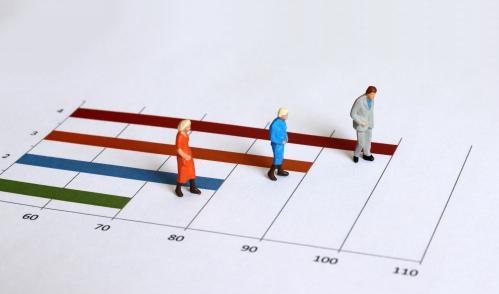Studies in this week’s Hutchins Roundup find that a nudge increased student borrowing and raised educational attainment, slow productivity growth is not the driver of persistently negative real interest rates, and more.
Want to receive the Hutchins Roundup as an email? Sign up here to get it in your inbox every Thursday.
Student loan nudge increases borrowing and raises educational attainment
Colleges must make federal loans available to all qualifying students, but choose whether to include a specific loan offer in financial aid letters. At one large community college, loan-eligible students were randomly assigned to receive either a letter mentioning loans without a specific amount, or one that offered $3,500 (for freshman) or $4,500 (for sophomores.) The wording of the letters didn’t affect students’ eligibility for loans. Benjamin Marx of the University of Illinois and Lesley Turner of the University of Maryland find that students who received nonzero loan offers were 40 percent more likely to borrow than those who received a zero offer. Further, students induced to borrow, on average, earned 3.7 more credits and increased their GPAs by 0.6 points in the year of the intervention. In the following academic year, nudge-induced borrowing generated a 10-percentage point increase in transfers to four-year institutions. Although all students received information on how to obtain federal loans, the nudge communicated loan information more effectively, the authors say.
Slow long-run productivity growth is not driving persistently negative real interest rates
Real interest rates have been consistently negative since 2008. One popular explanation is the slow-down in productivity growth. Examining interest rates and productivity growth from 1914-2016, Kurt Lunsford of the Cleveland Federal Reserve finds that low productivity growth historically has been associated with high real interest rates. But limiting the analysis to 1948-2016, the correlation disappears, suggesting that factors other than productivity growth are important in understanding long-run movements in real interest rates. For example, he suggests that aging baby boomers may have increased their savings in anticipation for retirement, exerting downward pressure on interest rates.
Some evidence undermines the natural rate hypothesis
The natural-rate hypothesis holds that, in the long run, unemployment and output are independent of monetary policy, and that monetary policy cannot hold unemployment below the natural rate without generating higher inflation. Both elements have been questioned—the level of output appears to have been permanently depressed by the Great Recession and very high unemployment didn’t lead to lower and lower inflation. In that light, Olivier Blanchard of the Peterson Institute for International Economics assesses the challenges to the natural-rate hypothesis and finds suggestive , though not conclusive, evidence undermining it. “Central banks,” he concludes, “should keep the natural rate hypothesis as their baseline, but keep an open mind and put some weight on the alternatives…[T]here is a strong case, although not an overwhelming case, to allow U.S. output to exceed potential for some time, so as to reintegrate some of the workers who left the labor force during the last ten years.”
Chart of the week: Labor force participation in blue states has pulled away from red states

Excerpts from Jerome Powell’s confirmation hearing:
Sen. Dean Heller, R-Nev.: “You’re about to become the most important economic policymaker in the world. How do you feel about that?”
Mr. Powell: “I feel fine about it.”
***
Sen. John Kennedy, R-La.: “Do we still have banks that are too big to fail in America?”
Mr. Powell: “I would say ‘no’ to that.”





Commentary
Hutchins Roundup: Student loan nudges, slow productivity growth and interest rates, and more
November 30, 2017